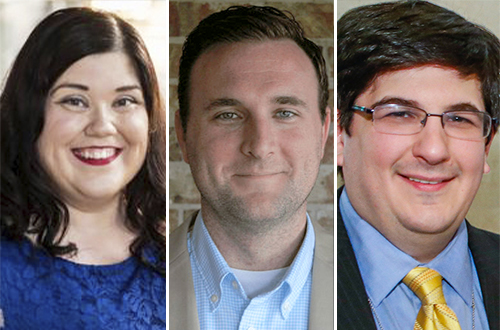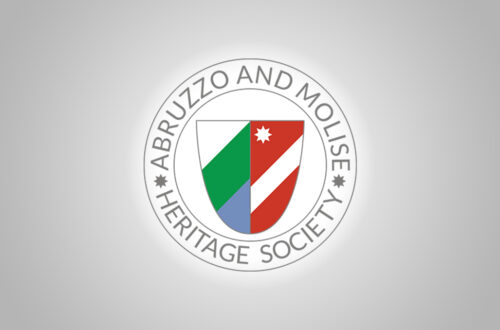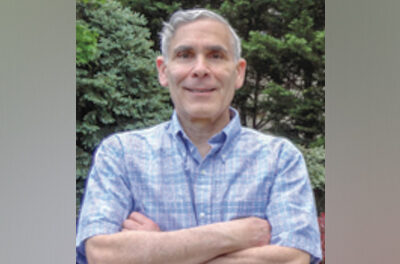-
AMHS Spring/Summer Programs for 2023
By Nancy DeSanti, 1st Vice President-Programs
Due to the ongoing renovations at Casa Italiana, we adapted and rescheduled our next in-person event for June 25, 2023. In the meantime, we have also scheduled two very interesting virtual programs which we hope our members will enjoy.

Stephanie Longo
Credit: stephanielongo.netOur first virtual program this Spring will be on Saturday, May 20, at 3 p.m. and it will be a workshop on preserving history, presented by Stephanie Longo of Dunmore, Pennsylvania. Before giving her presentation, she will say a few words about her own Italian heritage and her work as a producer on the very popular “The Italian-American Podcast,” which is devoted to helping Italian Americans celebrate their heritage.
A dual citizen of the United States and Italy, Stephanie is a frequent speaker about Italian immigration to the United States, particularly in Northeastern Pennsylvania. She is a graduate of the University of Scranton, earned a Master’s Degree from Regent University, and she is now working on her doctorate. Stephanie said she has made it her mission to continue to preserve the history which her ancestors brought to America from Guardia Lombardi (Avellino province in Campania) and Lamezia Terme (Catanzaro province in Calabria).
Stephanie’s presentation will be an interactive workshop designed to give participants the necessary tools to begin preserving their local history. Topics covered will include sourcing material, writing, and eventual publication. Participants are encouraged to bring any ideas they might have for possible discussion.
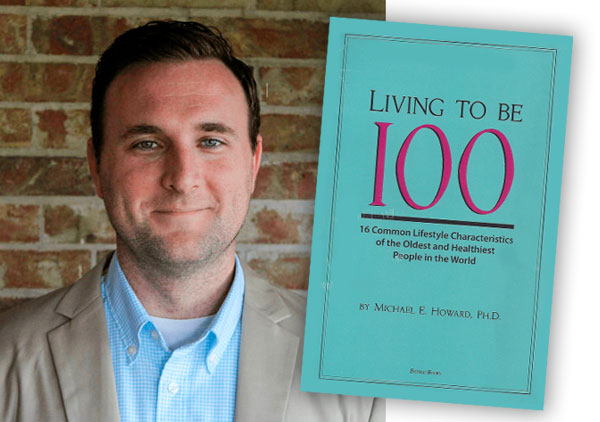
John Michael Howard
Credit: Courtesy of John Michael HowardOur second virtual program, on Sunday, June 4, at 7:30 p.m. will feature John Michael Howard who will talk to us about “Living To Be 100 (or 104, like Joe Rollino).”
The story John will tell us about Rollino, a strongman, weightlifter, and life-long vegetarian, is a fascinating one. He was the Brooklyn-born son of Italian immigrants and a decorated World War II veteran who called himself “the world’s strongest man” in the 1920s. John will talk to us about a book entitled, “Living To Be 100,” defining terms used in the health science field and making five points about aging well. He will follow up by briefly discussing the five “blue” zones, including Sardinia, where there is a very high occurrence of centenarians. Next, he will identify 16 lifestyle characteristics of centenarians, including their eating the Mediterranean Diet.
John is a native of Texas who comes by his Italian heritage on his paternal grandmother’s side. He graduated from the University of Dallas in 2016 and earned a Master’s Degree from Marymount University in Arlington, Virginia, in 2021. He is currently a counselor in Arlington and resides in Northeast Washington, D.C.
The book which is the subject of John’s talk, “Living To Be 100,” was published by Biomed Books in 2018 and was written by Dr. Michael E. Howard who teaches psychology at Texas State University in San Marcos.
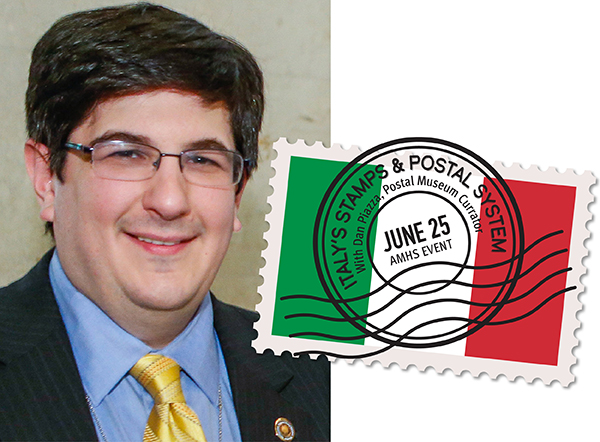
Dan Piazza, Chief Curator of the Smithsonian’s National Postal Museum Our in-person event will be a luncheon program at Casa Italiana on Sunday, June 25 at 1:30 p.m. and will feature AMHS member Daniel A. Piazza, who will give us fascinating details on Italian stamps and the Italian postal system. His knowledge of so many “fun facts” is bound to make his talk entertaining as well as informative.
Dan has been the Chief Curator of the Smithsonian’s National Postal Museum since 2014. He is responsible for exhibitions, acquisitions, and research related to the museum’s collection of six million postage stamps and postal artifacts comprising one of the largest such collections in the world. Visitors might be surprised to learn that despite its name, about half of the material is international, from all around the world. The museum, located a few blocks from Casa Italiana, opened to the public in 1993.
Since Italy was not unified until 1861, its early postal history is tied to the various kingdoms that ruled the peninsula. The history of Italian stamps from pre-unification through the Fascist period until the Italian Republic is full of interesting controversies which Dan is very knowledgeable about. He will also tell us how the Italian postal system works — or does not.
AMHS members may recall that, in July 2022, Dan gave us a fascinating virtual talk on Italian stamps during the Fascist period of 1922-1941. Also, in October 2022, he gave AMHS members a private tour of the baseball exhibit he curated at the National Postal Museum.
For the two virtual programs, a Zoom link will be available shortly beforehand on our website and via e-mail. For the in-person luncheon program, the registration period will open in early June.
May/June 2023
-
A Message from the President
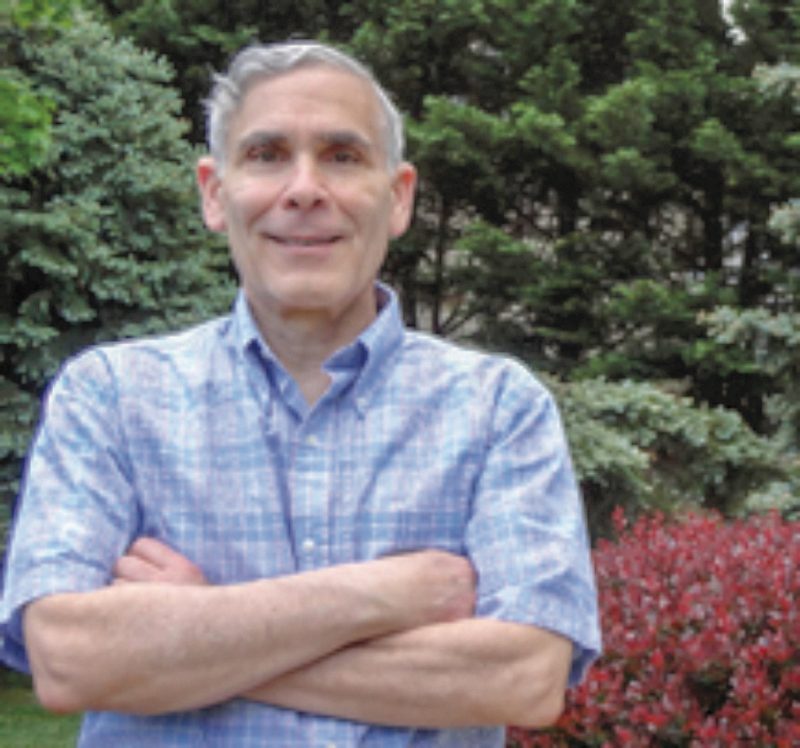
Dear members and friends:
I hope that you are enjoying the warmer weather and longer days of Spring. For me, the unusually mild Winter that we had does not make the Spring season any less anticipated or less enjoyable.
As some of you know, we closed out our Winter activities with a visit on March 11th to Don Ciccio & Figli, a distillery of Italian liqueurs located in northeast Washington. Some AMHS members and friends had a sweet time tasting the liqueurs and enjoying each other’s (and the owner’s) company. Look at Immediate Past President Maria D’Andrea-Yothers’ article inside this newsletter for a picture and description of the delightful afternoon.
We had to postpone our planned second general meeting of 2023 due to the renovations taking place in Casa Italiana. The new date for the program will be June 25th and the speaker remains the same – Daniel A. Piazza, the Chief Curator of the National Postal Museum. It will start at 1:30 p.m. in Casa Italiana. Prior to Dan’s presentation, we will hold two virtual programs that we hope you will find interesting. On Saturday, May 20th, at 3 p.m., we will feature Stephanie Longo, who is a writer specializing in Italian-American regional history, heritage, and culture. On Sunday, June 4th, at 7:30 p.m., clinical psychologist, John Michael Howard, B.A., M.A., will deliver a virtual presentation on the book “Living to be 100” by Dr. Michael E. Howard. John will discuss the five “blue” zones in the world, including Sardinia, where there is a high concentration of centenarians. He will also speak about the Mediterranean diet. You can find additional details on these events in an article inside this edition, written by 1st Vice President-Programs, Nancy DeSanti. Be sure to check it out so that you know about our upcoming attractions.
The brainstorming group assessing the operations of our Society is continuing its work. As I mentioned in my last message, the group was commissioned by the AMHS Executive Committee and was tasked with reviewing how we are organized internally, whether we might be able to facilitate better the organization of events and perhaps even diversify those events, and how we can better interface with other Italian-American organizations in the community. We will keep you apprised of the outcome and any recommendations approved by the Executive Committee.
The application period for our scholarships has drawn to a close and the Scholarship Committee is in the process of reviewing all the documentation submitted by the applicants. As you may recall, the AMHS is now managing an additional scholarship program — the Angela Lastrico Raish scholarship for students majoring in the music arts field. That program is off to a good start. We will announce the winners of both scholarship programs in the next edition of the Notiziario.
On March 28, AMHS founder and President Emeritus Lucio D’Andrea celebrated his 90th birthday! What a special day for him, his family, and us! You can view an article and photo of the family celebration in the Siamo Una Famiglia section inside. Belated wishes to Lucio and many happy returns! I am sure that you do not need me to point out that our many delightful programs and events over the years, as well as all the beautiful friendships we have made inside our Society, would not have been possible without Lucio’s initiative and perseverance.
Finally, do not forget that we have an online AMHS store that offers unique gifts displaying our logo for every season of the year and many special occasions. Click on the Our Heritage/Shop tab on the Society’s website:
Thank you for reading and have an enjoyable rest of your Spring!
Best regards,
Ray LaVerghetta
May/June 2023
-
The Abruzzo Connection of WNBA Star Elena Delle Donne
By Joseph “Sonny” Scafetta, Jr.

Elena Delle Donne
Credit: Ned DishmanAs the Women’s National Basketball Association (WNBA) begins its 2023 season, the Notiziario profiles one of the league’s brightest stars, Elena Delle Donne who has roots in Abruzzo.
Elena Delle Donne was born in Wilmington, Delaware, on September 5, 1989. She is the third child of Ernest Delle Donne and his wife. Elena’s paternal grandmother was Elena Calvarese who had emigrated from Abruzzo. Elena fondly recalls Sunday evening dinners which a great uncle would prepare for her large family. Elena’s older sister, Elizabeth, is blind, deaf, mute, autistic, and afflicted with cerebral palsy. Elena cares for her during the off season. Elena’s older brother, Eugene, works with his father in the family real estate developing business.
Elena’s father is 6’6″ and her mother is 6’2″, so Elena grew to be 6’5″ tall. She played volleyball and basketball in an all-girls high school named Ursuline Academy in Wilmington. She led Ursuline to the 2007 state volleyball championship and three straight state basketball championships. As a result, she became the player most sought after by colleges.
When she graduated in 2008, she decided to enroll in the University of Delaware where she played volleyball during her first year. In her second year, she switched to play basketball. At the end of the season, she was voted Rookie of the Year and Player of the Year. Only one woman and no men had won both college honors before Elena. During her next year, she was diagnosed with Lyme disease which was caused by an infected tick that bit her in the family backyard. As a junior, she returned to lead the nation in scoring with an average of 28 points per game. In her senior year, Elena helped her team win the Colonial Athletic Association Conference Tournament.
After graduation, she was selected second in the WNBA Draft by the Chicago Sky. At the end of the 2013 season, she was named Rookie of the Year. She missed most of the 2014 season due to a reoccurrence of Lyme disease. She returned to form in 2015, was the scoring champion with 23.4 points per game, and was named the WNBA Most Valuable Player (MVP). In 2016, she led her team to the playoffs but season-ending surgery on her right thumb kept her out of the playoffs. After she recovered, she helped the United States win the gold medal in women’s basketball at the Olympic Games in Rio de Janeiro.
With her four-year rookie contract expiring and with her approaching restricted free agent status, Elena was traded to the Washington Mystics in the 2017 off season. On November 3, 2017, she married Amanda Clifton at the Hempstead House in Sands Point, New York. They have no children. Due to the absence of a key player, the Mystics coach switched Elena from her usual position as a shooting guard to the starting power forward position where she led the team for the first time to the WNBA semi-final round which the team lost. When 2018 began, she helped the United States win the gold medal in the World Cup competition held throughout Spain. During the subsequent WNBA season, she led the Mystics to the final round for the first time, but unfortunately, they lost. In the 2019 season, she helped the Mystics become the number 1 seed in the WNBA playoffs which they won for the first time in franchise history. Also, Elena won the MVP award for the second time in her career. More importantly, she became the first woman to join the prestigious 50-40-90 club of players to make in one season 50% of her field goal shots, 40% of her three-point shots, and 90% of her free throws. Only nine men had previously achieved that feat. In 2020 and 2021, she sat out both seasons due to her vulnerability to COVID-19. Nevertheless, she was named to The W25 which is a list of the best 25 players during the WNBA’s first 25 years. In 2022, Elena played in her seventh All-Star Game. She looks forward to playing this coming season which begins on May 19,2023.
Sources:
- en.wikipedia.org/wiki/Elena_Delle_Donne (accessed November 13, 2022)
- Voce Italiana, November 2022, at pages 1 & 8
- Daily Mail, November 13, 2017, at pages 1 & 2
May/June 2023
-
Abruzzo’s Strong Mark on the World of Professional Wrestling
By Joseph “Sonny” Scafetta, Jr.
(Editor’s Note: Professional wrestling, with its colorful characters and slam bang action has attracted a loyal fan base for decades. The Notiziario’s Joseph “Sonny” Scafetta, Jr., profiles two legends of the sport who hailed from Abruzzo.)
“Baron” Michele Leone

The Baron in his heyday.
Credit: ringthedamnbell.files.wordpress.comMichele Leone was born on June 8, 1909, to Giovanni and Anna Leone in Pettorano sul Gizio, (population 1,376 in the 2015 Census) which is a town along the Gizio River just south of Sulmona in the province of L’Aquila in the region of Abruzzo. Despite his parents’ disapproval, he began wrestling at an early age under the tutelage of his uncle, Michele Leone, and became the town champion at age 14. He graduated from the local high school in 1927.
In 1933, he began to travel the European circuit. In early 1938, the 28-year-old Leone immigrated to New York City where he continued to wrestle. In June 1940, he relocated to Washington, D.C., and wrestled there too. When Italy declared war on the United States on December 8, 1941, he became an enemy alien and an instant “bad guy”. He was viewed as such a bad guy that he was even booed in a match against a German wrestler named Hans Kampfer. Nevertheless, before a match with Duke Keomuka, an “evil” Japanese wrestler, he gave a speech which so impassioned the crowd that they bought $2,000 in U.S. war bonds. He also appeared at charity events to sell U.S. war bonds at the Navy Yard in Philadelphia. After World War II ended in August 1945, he started wrestling up and down the east coast and began to draw big crowds.
In October 1949, he moved to Los Angeles and adopted the nickname “Baron”, portraying himself as an Italian aristocrat. The advent of television converted the journeyman into a super star. As he climbed the pro wrestling ladder, he defeated Italians Leo Garibaldi and Antonino Rocca before facing Mexican Enrique Torres for the World Heavy Weight Championship in the Olympic Auditorium on November 22, 1950, in front of 10,400 fans. The “Baron” pinned Torres in two out of the three falls to win the match and the world title. During his time as the champ, guest spots on TV shows raised his name recognition and appearances at department stores often drew more than a thousand fans. As an eligible bachelor, he attracted many women to whom he each gave an orchid and an autographed photo of himself.
On May 21, 1952, the 43-year-old Leone lost the title to Lou Thesz at the Gilmore Field in Hollywood. The match attracted more than 25,000 fans and was the first pro wrestling match to take in more than $100,000 at the gate. Four months later, on September 23, 1952, fellow Abruzzese Rocky Marciano won the World Heavy Weight Boxing Championship. In 1954, the “Baron” married Billie. They had no children. After losing his third rematch with Thesz in 1955, he retired at age 46. On May 17, 1963, the World Heavy Weight Wrestling Championship was won by another Abruzzese, Bruno Sammartino, who held it until April 30, 1977.
Since he had become independently wealthy because of his prize money, Leone bought an apartment building in Santa Monica which he moved into with his bride after retiring and where he lived quietly off his rental income and investments. While he was crossing a street near his home on November 14, 1988, he was struck by a speeding automobile and was taken to the nearby UCLA Medical Center. He died there from his injuries 12 days later. He was 79 years old.
In 2000, Billie Leone donated $100,000 in her husband’s memory to the Santa Monica Historical Society Museum for construction of the museum at a new location. This donation was the same amount as the gate at Leone’s last championship match. “Baron” Michele Leone was inducted into the Pro Wrestling Hall of Fame in 2019 during which he would have turned 110.
Sources, all accessed February 26, 2023:
Bruno Sammartino

The Champ, Bruno Sammartino
Credit: WikipediaBruno Leopoldo Francesco Sammartino was born on October 6, 1935, in the community of Pizzoferrato (population 1,163 in the 2004 Census), in the province of Chieti in the region of Abruzzo, Italy. He was the youngest of seven children born to Alfonso and Emilia Sammartino. After World War II started on September 1, 1939, his father fled Italy for Pittsburgh, Pennsylvania. When Italy switched sides and Germany invaded Italy in 1943, Emilia hid her seven children in a cave in a nearby mountain called Valla Rocca while she sneaked into the village at night for food and supplies. Before the war ended in Europe in May 1945, four of Bruno’s six older siblings had died due to various causes. Finally, in 1950 when Bruno was 15, his father was able to send money for his wife and three surviving children to join him in Pittsburgh.
Upon arrival, Bruno spoke no English and was a 90-pound weakling due to the deprivations of the war years. Thus, he was an easy target for bullies at Schenley High School. To build himself up, he started lifting weights and wrestling. He graduated from high school in June 1953. After six more years of body building, he set a world record in early 1959 by bench pressing 565 pounds. He then married his wife Carol with whom he had three sons: David and twins Daniel and Darryl. Bruno’s world record attracted the attention of Rudy Miller, a local professional wrestling promoter. Bruno made his pro debut in Pittsburgh on December 17, 1959, by pinning Dmitri Grabowski in 19 seconds. Bruno’s first match in Madison Square Garden in New York City occurred on January 2, 1960, when he pinned “Bull” Curry in five minutes. In March 1962, Bruno made his Canadian debut in Toronto which had a large Italian population at that time.
On May 17, 1963, Bruno won the Heavy Weight Championship of the World Wide Wrestling Federation (WWWF) by pinning the reigning champion, “Nature Boy” Buddy Rogers, in 48 seconds. Bruno held the championship belt for seven years and eight months until January 18, 1971, when he lost to Ivan Koloff in Madison Square Garden. However, on December 10, 1973, Bruno regained the championship belt by defeating Stan Stasiak. His second title run lasted three years and almost five months until April 30, 1977, when Bruno lost to “Superstar” Billy Graham. He then became a color commentator for the syndicated programs of the World Wrestling Federation (WWF) which had replaced the WWWF.
In 1985 when Bruno was 50, his son David, who also had become a pro wrestler, convinced Bruno to join with him as a wrestling tag team. Bruno’s final match occurred in Baltimore, Maryland, on August 29, 1987. Afterwards, Bruno became an outspoken critic of the WWF because it permitted the use of steroids. Then, while working as a color commentator for the Universal Wrestling Federation (UWF), he also occasionally acted as a referee.
On March 25, 2010, Bruno was honored with a Lifetime Achievement Award at the annual Dapper Dan Dinner in Pittsburgh. On April 6, 2013, in Madison Square Garden, he was inducted into the World Wrestling Entertainment (WWE) Hall of Fame. Bruno agreed to be inducted only because the WWE, which had replaced the WWF, banned the use of steroids. Six weeks later, May 17, 2013, was declared Bruno Sammartino Day in Pittsburgh. After two months in the hospital, he died on April 18, 2018, in Pittsburgh at age 82 due to multiple organ failure caused by heart problems. He remains the World Heavy Weight Wrestling Champion with the longest stint totaling eleven years and almost one month over two reigns.
Sources, all accessed July 27, 2020:
May/June 2023
-
Siamo Una Famiglia

The D’Andrea Family Celebrates 90th Birthday of AMHS Founding President
By Maria D’Andrea-Yothers
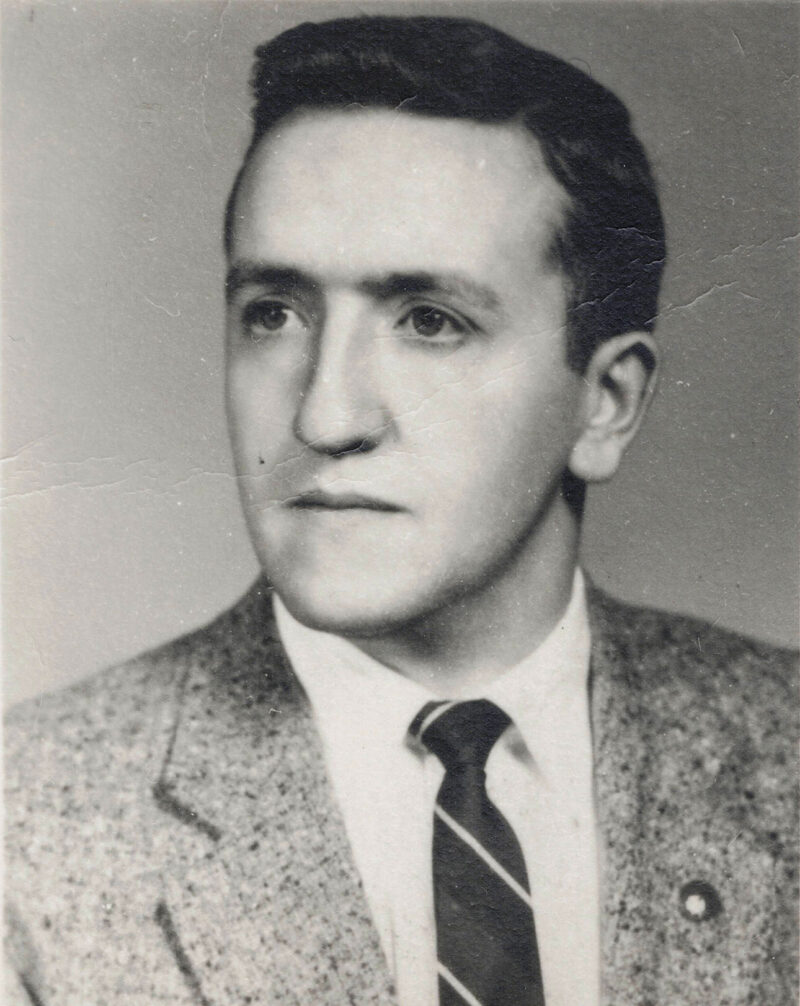
Lucio as a young man ready to take on the world.
Credit: Photo courtesy of the D’Andrea familyOn Friday, March 31, 2023, 29 members of the D’Andrea (Pitassi) family gathered to celebrate Lucio’s 90th birthday. The D’Andrea children hosted the family celebration at Osteria da Nino in Shirlington, Va., where owner Nino Pino and his team took exceptional care of the group with food, wine, and celebration. In attendance were Lucio’s loving wife, Edvige; his six children Candida, Maria (Sam), Sandra (Rial), Lisa (Dave), Laura (Lenny), and Paul (Susanna); his seven grandchildren Angela (Daniel), Sydney, Mikayla, Chiara, Justin, Tyler, and Gabriel; his great granddaughter Lillie (and Sam’s children Mara, husband John, and daughter Lauren); and nieces Rebecca (Russ) and Leda (Jeff), who celebrated Lucio’s life, love, and longevity, and made it a birthday to remember, “one for the ages.”
Lucio’s Brief Immigrant History & the Founding of the Abruzzo Molise Heritage Society (AMHS)
Lucio was born on March 28, 1933, in the village of Roccamandolfi, province of Isernia, in the region of Molise. He immigrated to the United States in 1948 along with his brother Joseph and Mother Candida to join his father, Gaetano, who lived in McKees Rocks, Pa., (just outside of Pittsburgh). Upon completion of his secondary school education, he enrolled at the University of Pittsburgh, graduating in 1957 with a Bachelor of Science degree in Petroleum Engineering and a commission as Second Lieutenant in the United States Army Corps of Engineers. Following his military service, he moved to Wyoming to work for an oil company. He later accepted a position with the Federal Power Commission in Washington, D.C. He served in a number of government agencies and, in 1986, he accepted an appointment by the Secretary-General of the United Nations to serve as Senior Economic Officer with the Economic Commission for Europe (ECE) in Geneva, Switzerland, becoming Deputy Director of its Energy Division. He retired from the ECE in 1983 and entered private practice as an energy consultant.
During his long professional and military career, Lucio received numerous awards and recognitions. One which he is particularly proud of is the “Order of Merit of the Republic of Italy,” which he received in 1972 for his involvement with the Italian Cultural Society in promoting Italian culture in the Washington, D.C., area. He has maintained a steadfast commitment to the promotion and development of Italian culture, traditions, and values. A testament to this commitment is Lucio’s creation and launch of AMHS.
In 1999, Lucio and his wife, Edvige — long-time members of Holy Rosary Church, along with Lucio’s brother Joseph, attended the “Primo Congresso Mondiale di Molisani di Nord America” (the First World Congress of Molisani in North America). The Congress was an occasion for Molisani in Canada to celebrate their success and achievements. Lucio, Edvige, and Joe were impressed and inspired by what they saw. It prompted Lucio and Edvige to explore the possibility of establishing a heritage society in the Washington, D.C., area.
To launch the Society, Lucio sought the help of Father Charles Zanoni, who was Pastor of Holy Rosary Church at that time. He agreed to place a notice in Voce Italiana, inviting readers to respond to the idea of establishing an Abruzzo and Molise Heritage Society. The response was encouraging. A core group of Abruzzesi and Molisani that Lucio and Edvige had come to know in their encounters at Holy Rosary Church and Casa Italiana was asked to join this initiative, namely Mario Ciccone, Ennio DiTullio, Tony D’Onofrio, Sergio Fresco, Gloria Sabatini, and Omero Sabatini. They all shared a common purpose for the creation of a society, to promote and perpetuate a common cultural heritage.
In June 2000, the inaugural meeting of the AMHS was held at Casa Italiana. Present were about 70 potential members including Joseph D’Andrea, President at the time of the Molisani Societies in the United States, Father Charles Zanoni, and First Counselor of the Embassy of Italy, Giampaolo Cantini. From a modest beginning, the society has grown and has pursued a host of activities and programs, becoming one of the most highly regarded Italian-American organizations in the Washington, D.C., area.I hope that the members of AMHS will send Lucio their congratulations, not only for celebrating a milestone birthday, but also for founding the society. Without Lucio, most likely, AMHS would not exist. Buon compleanno Lucio!
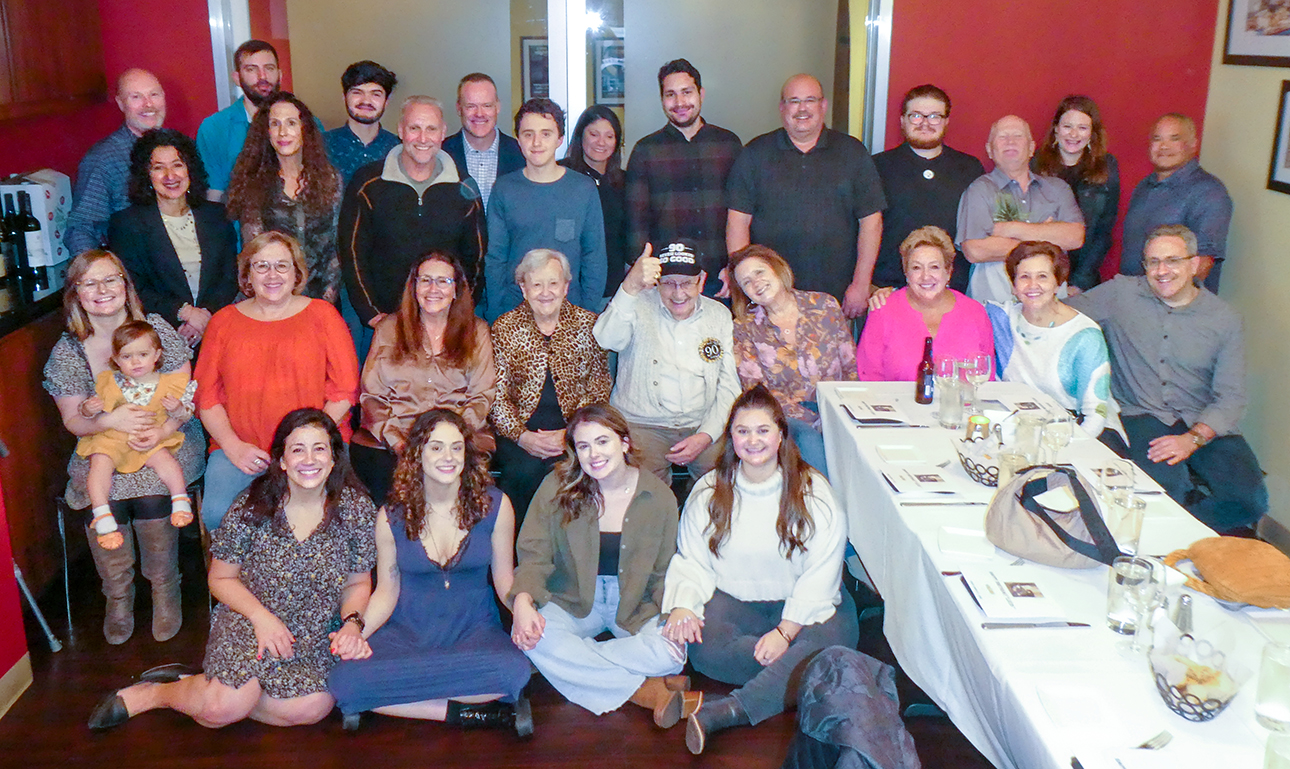
Lots of love in the room at Lucio’s 90th birthday celebration.
Credit: Photo courtesy of the D’Andrea familyAMHS Outing to Don Ciccio & Figli
By Maria D’Andrea-Yothers
On Saturday, March 11, a group of 16 AMHS members and friends went to Don Ciccio & Figli, a distillery of Italian liqueurs, located in the Ivy City neighborhood of Northeast D.C. The group tasted 17 liqueurs, from bitter to sweet, all of which can be used to mix with liquor for Italian cocktails. Aaron, an associate, took great care of our group, describing each liqueur that we tasted and what they are best to mix with for cocktails.
After the tasting, a group of us enjoyed Don Ciccio & Figli cocktails and light snacks at the company’s Bar Sirenis. A lovely time was had by all. Special thanks to Francesco Amodeo for taking good care of our group. Francesco told us that he looked us up and thoroughly enjoyed perusing our website. Thanks also to AMHS members Chris Renneker, Mark Lino, and Maria D’Andrea-Yothers for planning and organizing the outing.
We highly recommend a visit to this distillery for anyone who lives in the Washington area or for our associate members, when you are in D.C. for a visit. The distillery is only open to visitors on Saturdays from 2:00 p.m. to 7:00 p.m.
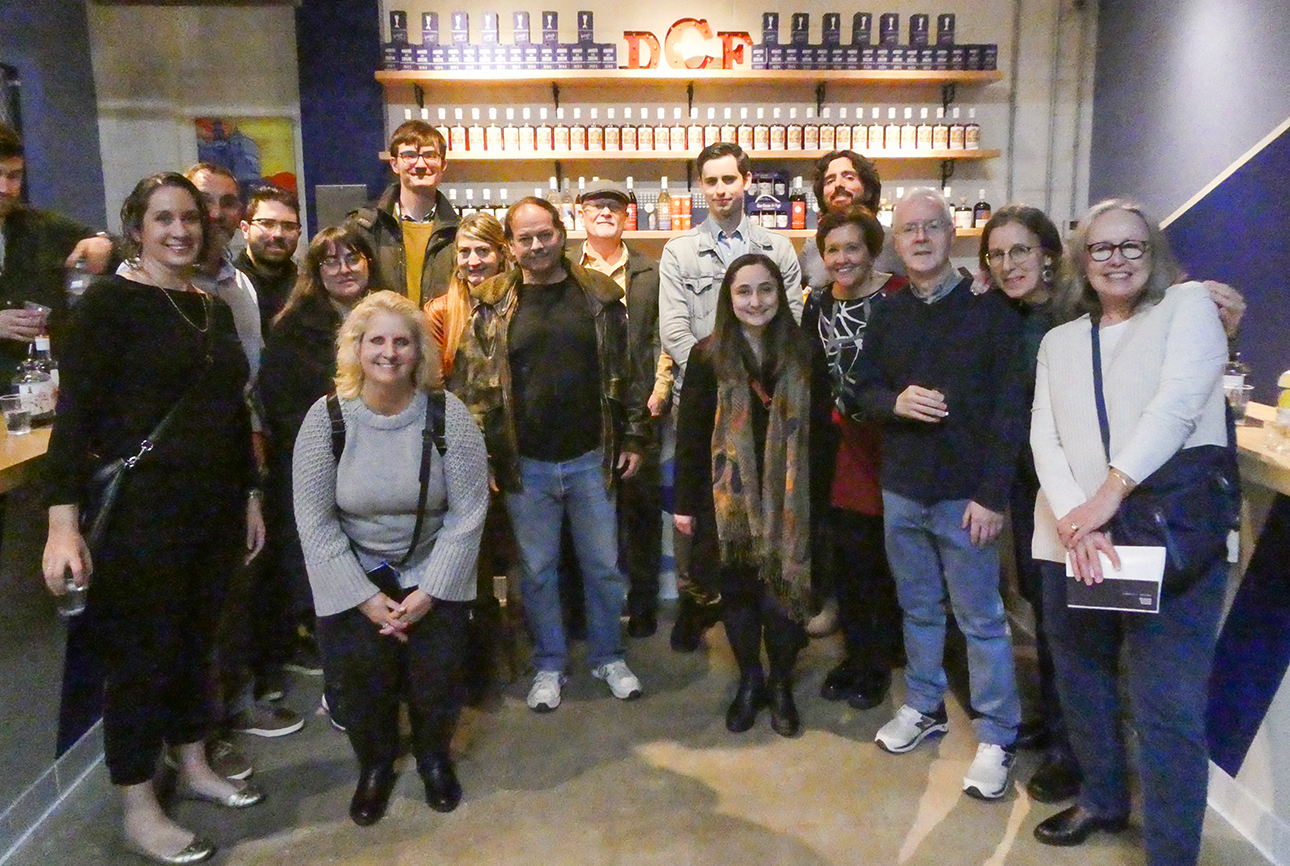
AMHS members and friends enjoyed the tasting room at Don Ciccio & Figli.
Credit: Provided by Sam Yothers
May/June 2023
